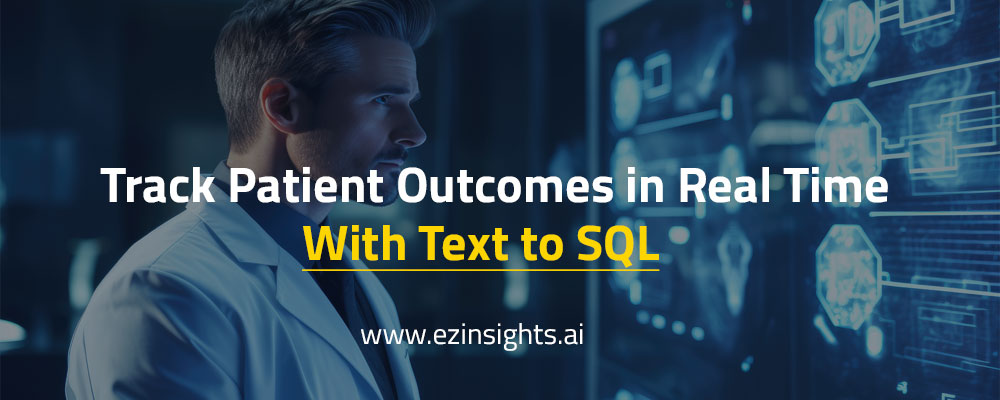In today’s data-driven healthcare world, tracking patient outcomes in real time is more important than ever. It helps doctors make faster decisions, improves hospital operations, and leads to better patient care.
But most Electronic Health Records (EHRs) and clinical databases use complex systems. This makes it hard for non-technical staff to get the insights they need, when they need them.
Text to SQL (T2SQL) offers a powerful solution to this problem. It lets users type plain language questions and instantly get structured SQL queries in return. With this, clinicians and administrators can pull real-time data from databases – without needing coding skills or technical training.
Jump to:
Why Real-Time Patient Outcome Tracking Matters
How Text to SQL Enables Real-Time Outcome Monitoring
Challenges in Querying Healthcare Databases
Benefits for Healthcare Organizations
Examples of Text to SQL in Healthcare
Best Practices for Implementation
What is Text to SQL?
Text to SQL uses natural language processing (NLP) to turn plain English questions into SQL commands. For example, a doctor can ask, “Show me all diabetic patients with an A1C level above 8 in the past month.” The system will convert this into SQL and fetch the data from the hospital’s electronic health records (EHR).
This tool removes the need to learn database languages. Clinicians no longer must depend fully on data analysts to get the insights they need.
Why Real-Time Patient Outcome Tracking Matters
Traditionally, patient outcome data is collected, analyzed, and reviewed retrospectively. This introduces delays in care adjustments, performance feedback, and policy decisions. In contrast, real-time tracking empowers healthcare providers to:
Detect adverse trends early (e.g., rising infection rates)
Identify concerning health patterns quickly to initiate timely interventions and prevent complications across departments.
Monitor recovery or deterioration in post-surgical patients
Track patient vitals and recovery metrics live to adjust care plans before conditions worsen.
Adapt treatment plans dynamically
Use up-to-the-minute data to personalize medications, therapies, or procedures for better outcomes.
Evaluate treatment efficacy during trials
Assess clinical trial results in real time, accelerating research insights and improving participant safety.
Enable precision medicine approaches at scale
Leverage continuous outcome data to tailor treatments based on genetic, demographic, and lifestyle factors.
Text to SQL supercharges this process by democratizing access to complex datasets across teams.
How Text to SQL Enables Real-Time Outcome Monitoring
Let us break down how this technology facilitates real-time insights:
- Natural Language Querying
Physicians and medical staff can ask outcome-related questions like:
- “How many COVID-19 patients have been readmitted within 30 days?”
- “What’s the average recovery time after hip replacement surgery for patients over 65?”
No technical knowledge is needed – just a clear, concise question.
- Instant SQL Generation
Advanced models like OpenAI’s Codex or open-source alternatives parse the question and generate SQL scripts on the fly. These scripts access live data from structured hospital databases.
- Visualization Integration
The SQL results can be automatically plugged into dashboards built with tools like Power BI, Tableau, or Streamlit, offering visualizations such as:
- Recovery trends over time
- Complication rates by department
- Outcome disparities by demographic groups
- Feedback Loop
Insights gained from real-time analysis can trigger automated alerts or recommendations. For instance, if post-operative infection rates exceed a set threshold, the system can notify staff to initiate an audit.
Challenges in Querying Healthcare Databases
Despite the growing availability of patient data, extracting meaningful insights from healthcare databases remains a significant challenge. These obstacles often stem from the complexity of medical information systems and regulatory environments. Key challenges include:
Complex Schema Structures
Healthcare databases have deeply nested schemas and hundreds of linked tables. This makes manual querying difficult, slowing access to real-time clinical insights for non-technical users across hospital systems.
Inconsistent Data Standards
Varying EHR vendors, coding systems (ICD-10, SNOMED), and data formats create fragmented healthcare records. Standardization is critical for accurate Text to SQL querying and reliable patient outcome tracking.
Lack of SQL Skills Among Clinicians
Most clinicians lack SQL expertise, making it hard to access structured healthcare data. Text to SQL bridges this gap, allowing medical teams to run queries using natural language.
Delayed Data Access
Healthcare data is often siloed, requiring approvals across departments. This delays real-time access to EHR data, limiting timely care decisions and operational efficiency for hospitals and clinics.
Benefits for Healthcare Organizations
Implementing real-time patient outcome tracking with Text to SQL brings tangible advantages to healthcare organizations at every level. From operational efficiency to enhanced patient satisfaction, here are the key benefits:
Faster Clinical Decision-Making
Text to SQL gives clinicians instant access to real-time healthcare data, enabling faster treatment decisions without relying on IT teams. This reduces delays and improves overall patient care efficiency.
Improved Patient Outcomes
With real-time data insights, healthcare providers can detect complications early and adjust treatments quickly. This leads to better patient outcomes, fewer readmissions, and improved care quality across departments.
Greater Operational Efficiency
Automating medical data queries with Text to SQL reduces manual reporting and streamlines hospital workflows. As a result, healthcare teams save time and focus more on patient-centered tasks.
Stronger Data-Driven Culture
Easy access to EHR data encourages staff to make informed, data-driven decisions. This improves clinical performance, accountability, and fosters a culture of evidence-based care across the healthcare organization.
Lower Healthcare Costs
Real-time patient tracking helps reduce medical errors, optimize resource use, and prevent costly readmissions. This directly supports financial sustainability and value-based care in modern healthcare systems.
Examples of Text to SQL in Healthcare
Monitoring Readmission Rates
Natural Language:
“Show me the number of heart failure patients readmitted within 30 days over the last quarter.”
SQL (auto-generated)
SELECT COUNT(*)
FROM admissions
WHERE diagnosis = ‘Heart Failure’
AND readmission = TRUE
AND DATEDIFF(readmission_date, discharge_date) <= 30
AND discharge_date >= DATE_SUB(CURDATE(), INTERVAL 3 MONTH);
Tracking Post-Surgical Infection Trends
Natural Language:
“How many knee replacement patients developed infections within 14 days post-surgery this year?”
SQL (auto-generated)
SELECT COUNT(*)
FROM surgeries
JOIN infections ON surgeries.patient_id = infections.patient_id
WHERE surgery_type = ‘Knee Replacement’
AND DATEDIFF(infections.diagnosis_date, surgeries.surgery_date) <= 14
AND YEAR(surgeries.surgery_date) = YEAR(CURDATE());
Evaluating Average Length of Stay by Department
Natural Language:
“What is the average length of hospital stay per department for the last 6 months?”
SQL (auto-generated):
SELECT department, AVG(DATEDIFF(discharge_date, admission_date)) AS avg_stay_days
FROM admissions
WHERE admission_date >= DATE_SUB(CURDATE(), INTERVAL 6 MONTH)
GROUP BY department;
Limitations and Challenges
While Text to SQL offers powerful capabilities in real-time data access and clinical decision support, there are important limitations and challenges that healthcare organizations must address to ensure effective adoption.
Accuracy of Query Translation
Natural language can be unclear. Without precise medical terms, Text to SQL may misinterpret questions, causing inaccurate query results. Clinicians must define clear thresholds for better healthcare data accuracy.
Complexity of Healthcare Data Models
Healthcare databases use complex relationships between patients, labs, and treatments. As a result, generating accurate SQL is difficult. Text to SQL systems need to understand deeply structured clinical data.
Limited Context Awareness
Most Text to SQL tools lacks medical context. For instance, they may miss connections like post-surgical infection timing. Therefore, clinical queries must include enough detail for accurate data interpretation.
Data Quality and Standardization Issues
Poor data quality – such as missing values or inconsistent coding – reduces query accuracy. Standardizing EHR data improves Text to SQL performance and ensures more reliable insights for clinical decision-making.
Best Practices for Implementation
Successfully deploying Text to SQL in a healthcare environment requires more than just installing a tool – it demands alignment across people, processes, data, and compliance standards. Below are the best practices to ensure a smooth and impactful implementation.
Define Clear Use Cases
Start with specific, high-value use cases (e.g., tracking readmissions or infection trends). This ensures early wins, builds confidence, and helps fine-tune query models around real operational needs.
Clean and Standardize Data
Ensure that databases use consistent formats, clinical codes (ICD-10, SNOMED), and timestamps. High data quality is essential for accurate query translation and meaningful results.
Use Role-Based Access Controls
Implement granular access policies so only authorized users can query sensitive patient data. This protects privacy and supports compliance with HIPAA and other regulations.
Provide Query Templates and Guided Prompts
Offer pre-built query examples or prompts within the system to help users form effective questions. This reduces errors and accelerates adoption, especially for non-technical staff.
Integrate with Existing Dashboards and Workflows
Embed Text to SQL into tools clinicians already use—like EHR dashboards, BI platforms, or clinical portals—to minimize workflow disruption and increase usability.
The Future of Text to SQL in Healthcare
As healthcare continues to digitize and prioritize data-driven care, Text to SQL will evolve from a support tool into a critical decision-making engine. Future advancements in large language models (LLMs) will enhance the contextual understanding of clinical queries, enabling more precise SQL generation—even from vague or conversational inputs. This will reduce reliance on technical teams and empower every healthcare worker to independently explore and interpret real-time data for better outcomes.
Moreover, integration with predictive analytics, voice assistants, and EHR systems will make querying as natural as speaking to a colleague. As interoperability standards improve, Text to SQL will not just extract data—it will surface personalized, predictive, and actionable insights across the entire continuum of care. In the coming years, it will become an essential layer in the healthcare AI stack, bridging the gap between raw data and real-time clinical intelligence.
Conclusion
Text to SQL presents a game-changing opportunity to make real-time patient data more accessible, interpretable, and actionable for healthcare professionals. By enabling natural language interactions with complex databases, healthcare systems can become more proactive, responsive, and efficient in delivering care.
As hospitals embrace AI, LLMs, and real-time analytics, Text to SQL will be a cornerstone of data empowerment in modern medicine.
Start with EzInsights AI for a free trial and experience how natural language queries can transform the way your organization accesses and utilizes healthcare data.
FAQs
What is Text to SQL in healthcare?
Text to SQL in healthcare uses AI to convert natural language questions into SQL queries. This helps doctors and staff access patient data from EHR systems without writing code.
How can Text to SQL improve patient care?
Text to SQL enables real-time access to critical patient information. Clinicians can make faster, data-driven decisions, which improves treatment accuracy and overall patient outcomes.
Is Text to SQL secure for use with patient data?
Yes, when implemented correctly. Text to SQL solutions must follow HIPAA and data privacy regulations. Role-based access controls and encryption ensure secure handling of sensitive healthcare data.
Do clinicians need technical training to use Text to SQL?
No. Clinicians simply ask questions in plain English. The system automatically converts those into SQL, allowing even non-technical users to access complex data easily.

Abhishek Sharma
Website Developer and SEO Specialist
Abhishek Sharma is a skilled Website Developer, UI Developer, and SEO Specialist, proficient in managing, designing, and developing websites. He excels in creating visually appealing, user-friendly interfaces while optimizing websites for superior search engine performance and online visibility.

